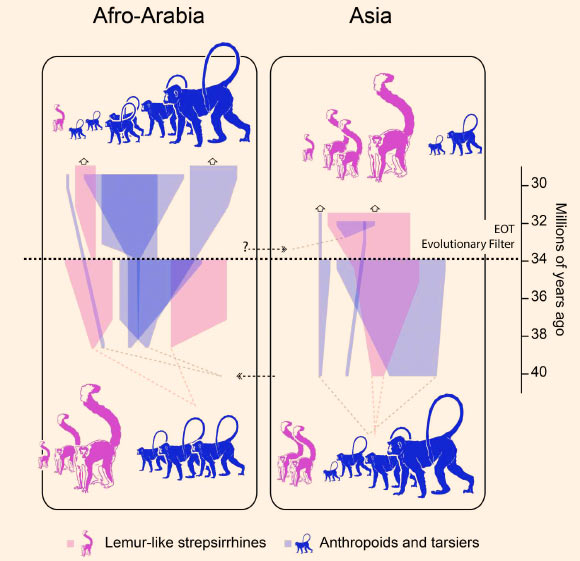In a study published online in the journal Science, paleontologists from China and the United States report the discovery of a diverse primate fauna from the early Oligocene of southern China.

The EOT transition functioned as a critical filtering episode during the evolutionary history of primates. Image credit: Xijun Ni
According to scientists, primates are sensitive to shifts in temperature, and thus, to climate change.
Changes in the distribution of primate fossils throughout time reflect this, with intervals of extreme warmth corresponding to expansions for these species, as reflected in the fossil record, and cooler periods — such as the Eocene-Oligocene transition (EOT), some 34 million years ago — resulting in primates’ extinction on large scales.
“At the Eocene-Oligocene boundary, because of the rearrangement of Earth’s major tectonic plates, you had a rapid drop in temperature and humidity,” said study co-author Dr. K. Christopher Beard, from the University of Kansas.
“Primates like it warm and wet, so they faced hard times around the world — to the extent that they went extinct in North America and Europe.”
“Of course, primates somehow survived in Africa and Southern Asia, because we’re still around to talk about it.”
Assessing the exact impact of EOT environmental changes on Asian primate evolution has been difficult given the lack of primate fossils from the region during that time.
To fill this gap, Dr. Beard and his colleagues studied the fossils of ten extinct primate species from Yunnan Province dated to the early Oligocene, the time just after the cooler transition, discovering that surviving the EOT required primates to adapt to lemur-like strepsirrhine primates.
“Like most of today’s primates, the ancient Chinese primates were tropical tree-dwellers,” Dr. Beard said. “One of the species, Oligotarsius rarus, was ‘incredibly similar’ to the modern tarsier found today only in the Philippine and Indonesian islands.”
“If you look back at the fossil record, we know that tarsiers once lived on mainland Asia, as far north as central China. The fossil teeth described in this paper are nearly identical to those of modern tarsiers. Research shows that modern tarsiers are pretty much living fossils – those things have been doing what they do ever since time immemorial, as far as we can tell.”
A similar comparison of Afro-Arabia fossils shows a very different pattern of adaptation in response to the EOT: very few strepsirrhines (a suborder of primates that includes lemurs) survived, whereas anthropoids (monkeys and apes) diversified.
The results suggest that the EOT functioned as a critical filtering episode during the evolutionary history of Asian primates, one that ultimately impacted the course of primate evolution across the Old World.
_____
Xijun N. et al. 2016. Oligocene primates from China reveal divergence between African and Asian primate evolution. Science, vol. 352, no. 6286, pp. 673-677; doi: 10.1126/science.aaf2107







